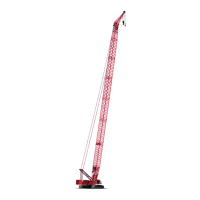Manitowoc Published 05-09-17, Control # 014-28 1-63
16000 SERVICE/MAINTENANCE MANUAL INTRODUCTION
Counterweight Lift Cylinder
See Figure 1-57 and Figure 1-58 in the following procedure.
When a MAX-ER chart is selected, a load sensing pin in one
mast strap monitors mast loading. The pin sends a variable
0.8 to 8.0 input voltage to the Node-1 controller for
controlling counterweight lift cylinder position. Node-1
controller converts the load-sensing pin voltage signal to U.S
tons that is displayed on MAX-ER information screen.
Counterweight lift cylinder automatically lifts the wheeled
counterweight assembly off the ground and sets it back down
when required depending on load (governed by boom angle,
boom length, lifted load). When the wheeled counterweight
assembly is off the ground, the crane can swing and travel in
the normal manner to position the crane and load. When the
wheeled counterweight assembly is on the ground, the
wheels must be properly positioned before swinging or
traveling the crane.
Node-1 controller monitors the MAX-ER’s electronic and
hydraulic systems to automatically extend and retract the
counterweight lift cylinder to raise and lower wheeled
counterweight assembly in response to changes in mast
load sensing pin tension (see MAX-ER Operator Manual).
Pressure senders are located at counterweight lift cylinder to
measure system inlet and outlet pressures and send the
pressure information as input voltage to Node-1 controller.
Information screen in operator’s cab indicates lift cylinder
pressures in inch or metric.
Counterweight lift cylinder position sensor monitors lift
cylinder shaft position and sends the information as input
voltage to Node-1 controller. Information screen in operator’s
cab indicates lift cylinder extend position in percent.
Counterweight Lift Cylinder Switch
Counterweight lift cylinder switch allows the lift cylinder to be
disconnected from mast straps during assembly/
disassembly. Power is available to hand-held wireless
remote control when, engine is running, MAX-ER function
mode is selected, and power button is pressed.
The counterweight lift cylinder has a counterbalance valve at
each cylinder port to provide smooth operation when
operating. Counterbalance valves lock cylinder in position.
and also provide relief protection for the cylinder. The
counterweight lift cylinder three position spool valves are
motor spooled where both cylinder ports and tank port of
valve spool section are connected in center position.
The crane accessory system pressure sender monitors
system pressure to counterweight lift cylinder system. Node-
1 controller also monitors the lift cylinder pressure senders in
both extend and retract directions. Node-1 controller sends a
pressure output to information screen in operator’s cab.
A position sensor at bottom of lift cylinder monitors and
sends a 0.8 to 8.0 voltage signal to Node-1 controller. Node-
1 controller sends a percent output to information screen in
operator’s cab.
Counterweight Lift Cylinder Extend
When counterweight lift cylinder switch is moved and held in
extend position, an input signal from wireless transmitter is
sent to a receiver on the crane. The receiver sends the input
signal to Node-1 controller. Node-7 sends a 24 volt output to
enable the counterweight lift cylinder solenoids HS-70 and
71 and shifts the valve to extend position.
Node-3 controller also sends a variable zero to 24 voltage to
enable proportional relief solenoid HS-68 to provide
approximately 4,500 psi (310 bar) pressure to counterweight
lift cylinder system.
Hydraulic pressure from accessory pump flows through
pressure control pilot valve, three bank manifold valve, and
enters free-flow check valve section of counterbalance
valve. Fluid pressure on piston end of cylinder extends the
cylinder to the desired length.
Hydraulic fluid from rod end of cylinder is blocked by free-
flow check valve section of counterbalance valve and flow
restraining section of relief valve preset for a relief setting of
2,200 psi (152 bar). Rod end cylinder pressure opens
restraining section of counterbalance valve, allowing fluid to
exit valve. Return hydraulic fluid passes through three bank
manifold valve before returning to crane hydraulic tank
through return line.
When desired extension is reached, release switch to lock
cylinder in position. Hydraulic fluid at piston end of cylinder
counterbalance valve holds lift cylinder in selected position.
When switch is released, an input signal is sent to Node-1
controller. Node-7 controller sends a zero volt output to
hydraulic solenoids HS-70 and 71 to return valve to center
position.
Node-3 sends a variable voltage output to accessory system
proportional relief solenoid HS-68 to provide approximately
3,000 psi (207 bar) system pressure.
WARNING
Collapsing Mast!
After mast straps are pinned to lift cylinder spreader, do
not manually retract counterweight lift cylinder. Mast can
be pulled over backwards. Lift cylinder automatically
adjust when MAX-ER is operating.
Tipping Hazard!
Counterweight lift switch can be used to extend mast
lifting cylinder manually if load-sensing pin fails. Any other
use of this control is neither intended nor approved.

